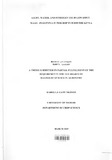| dc.description.abstract | A field experiment was conducted to investigate light, water and nitrogen use in a
low input maize-pigeonpea intercrop system in sub-humid conditions at the
University of Nairobi, Kabete Field Station. Treatments were three pigeonpea
(Cajanus cajan) varieties; a medium duration (ICEAP 00557) and two long
duration types, semi-erect (ICEAP 00040) or erect (ICEAP 00053), planted alone
or intercropped with maize (Zea mays)(HSll). Two cotton (Gossypium hirsutum)
varieties (Hart 89 M and UKA 59/146) were used as reference crops to determine
amount of N fixed by pigeonpea using the N difference method. The experiment
was laid out in a randomized complete block design (RCBD) replicated six times.
Data on canopy light interception, changes in soil water, crop dry matter
accumulation, grain yield, plant total nitrogen and soil mineral N at key phenological
stages was determined. There were two maize cropping seasons; April-September
2001 and October- April 2002 as seasons 1 and 2 respectively, but one season of
pigeonpea crop.
Peak photosynthetically active radiation (PAR) interception in intercropped
pigeonpea occurred after maize was harvested in both seasons. The long duration
.yarieties intercepted more PAR than medium duration variety. The long dura.tion
pigeonpea intercrop extracted more soil water than either of the component sole
crops. Long duration pigeonpea had a larger canopy and extracted more soil water
than the medium duration pigeonpea Sole maize had highest water use efficiency
while sole pigeonpea had the least. Maize average grain yield was 4339 kg ha" and
that of pigeonpea was 1400 kg ha". Long duration pigeonpea had significantly
higher yield (1600 kg ha') than medium duration pigeonpea (935 kg ha"). The
land equivalent ratio (LER) was 1.0,0.96, and 0.84 for maize intercropped with the
ICEAP 00040, ICEAP 00053 or ICEAP 00557, respectively, indicating lack of
pigeonpea - maize-intercropping advantage.
There was better N use in the intercrop than in the sole cropped pigeonpea system
The long duration pigeonpea :fixed more nitrogen than the medium duration one
early in the season. It was difficult to estimate the amount ofN fixed by pigeonpea
later in the season because cotton, the reference crop, accumulated more biomass
than pigeonpea. Pigeonpea litter fall N contribution ranged from 58 kg ha" to 92
kg ha-l in intercropped medium and long duration pigeonpea, respectively.
The average grain yield of maize obtained from plots previously planted with the
sole of the long duration pigeonpea erect was higher (3940 kg ha") than from the
plots that were previously intercropped with pigeonpea (3521 kg ha" ) or those that
were continuously planted with maize (1833 kg ha"). This may be an indication of
increased nutrient supply from decomposed litter. Intercropping of maize with
long duration pigeonpea improved light, water and nitrogen use in the system more
than the medium duration pigeonpea. | en |

